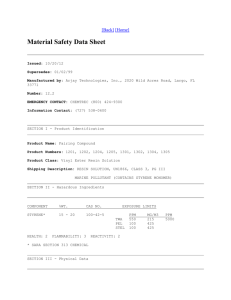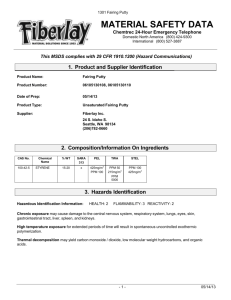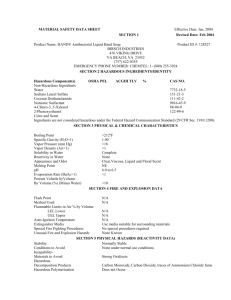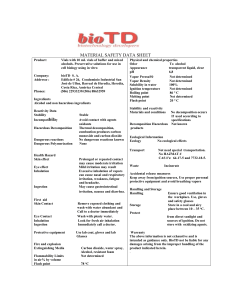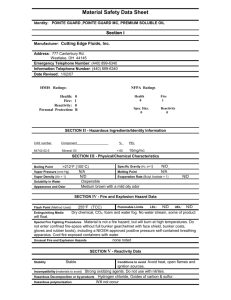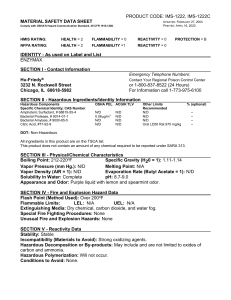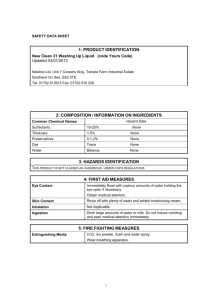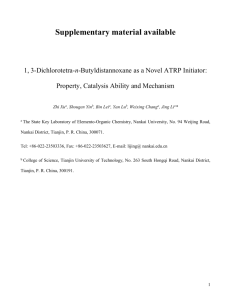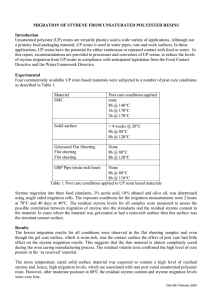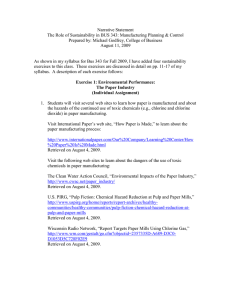MSDS 1 - Fiberlay
advertisement
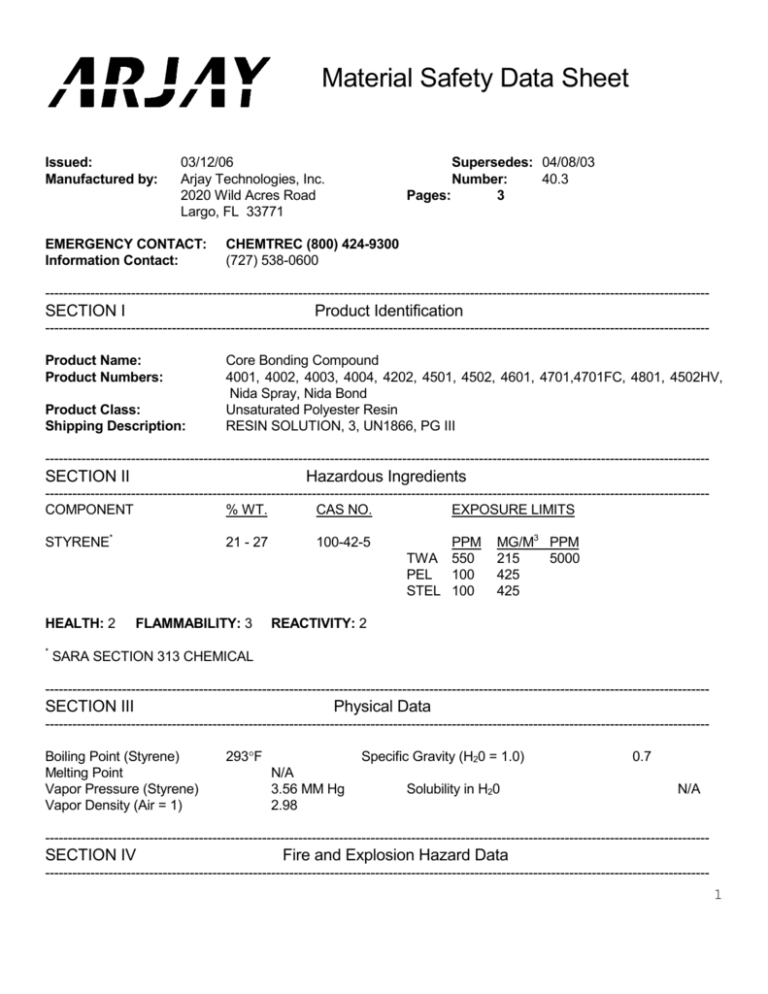
Material Safety Data Sheet Issued: Manufactured by: 03/12/06 Arjay Technologies, Inc. 2020 Wild Acres Road Largo, FL 33771 EMERGENCY CONTACT: Information Contact: Supersedes: 04/08/03 Number: 40.3 Pages: 3 CHEMTREC (800) 424-9300 (727) 538-0600 --------------------------------------------------------------------------------------------------------------------------------------------------- SECTION I Product Identification --------------------------------------------------------------------------------------------------------------------------------------------------Product Name: Product Numbers: Product Class: Shipping Description: Core Bonding Compound 4001, 4002, 4003, 4004, 4202, 4501, 4502, 4601, 4701,4701FC, 4801, 4502HV, Nida Spray, Nida Bond Unsaturated Polyester Resin RESIN SOLUTION, 3, UN1866, PG III --------------------------------------------------------------------------------------------------------------------------------------------------- SECTION II Hazardous Ingredients --------------------------------------------------------------------------------------------------------------------------------------------------COMPONENT % WT. CAS NO. EXPOSURE LIMITS STYRENE* HEALTH: 2 * 21 - 27 FLAMMABILITY: 3 100-42-5 PPM TWA 550 PEL 100 STEL 100 MG/M3 PPM 215 5000 425 425 REACTIVITY: 2 SARA SECTION 313 CHEMICAL --------------------------------------------------------------------------------------------------------------------------------------------------- SECTION III Physical Data --------------------------------------------------------------------------------------------------------------------------------------------------Boiling Point (Styrene) Melting Point Vapor Pressure (Styrene) Vapor Density (Air = 1) 293F Specific Gravity (H20 = 1.0) N/A 3.56 MM Hg 2.98 Solubility in H20 0.7 N/A --------------------------------------------------------------------------------------------------------------------------------------------------- SECTION IV Fire and Explosion Hazard Data --------------------------------------------------------------------------------------------------------------------------------------------------- 1 Flash Point (Styrene) Flammable Limits (Percent by Volume) Extinguishing Media: Special Fire Fighting Procedures: Unusual Fire and Explosion Hazards: 90 F PENSKY-MARTEN CLOSED CUP LEL : 1.10% UEL : 6.10% Use foam, carbon dioxide or chemical fire fighting apparatus. Cool tanks and drums with water. Firefighters should wear self contained breathing apparatus and protective clothing. High temperature exposure for extended periods of time will result in spontaneous uncontrolled exothermic polymerization. -------------------------------------------------------------------------------------------------------------------------------------------------- SECTION V Reactivity Data -------------------------------------------------------------------------------------------------------------------------------------------------Stability: Stable under normal conditions. Avoid exposure to temperatures above 100 F or 38C. Incompatibility: Avoid contact with strong mineral acids, peroxides, oxidizing agents, and polymerization catalysts. Hazardous Polymerization: Can occur Hazardous Decomposition Products: Thermal decomposition may yield carbon monoxide/dioxide, low molecular weight hydrocarbons, and organic acids. -------------------------------------------------------------------------------------------------------------------------------------------------- SECTION VI Health Hazards -------------------------------------------------------------------------------------------------------------------------------------------------MAJOR EXPOSURE HAZARD: INHALATION, SKIN CONTACT, EYE CONTACT Effects of overexposure: Eye Contact: Skin Contact: Inhalation: Ingestion: Severe irritation, redness, tearing, blurred vision Prolonged or repeated exposure can cause moderate irritation, de-fatting, dermatitis, and sensitization. Excessive inhalation of vapors can cause nasal and respiratory irritation, dizziness, weakness, fatigue, nausea, and headache. High concentrations may result in narcosis (central nervous system depression). Can cause gastrointestinal irritation, nausea, vomiting and diarrhea. Aspiration of material into lungs can cause chemical pneumonitis, which can be fatal. Chronic exposure may cause damage to the central nervous system, respiratory system, lungs, eyes, skin, gastrointestinal tract, liver, spleen, and kidneys. Other health effects: IARC (International Agency for Research on Cancer) has re-classified styrene from a Group 3 substance to a Group 2B substance. This is not based on any significant new evidence that styrene might be carcinogenic, but rather on a broadening of the definition for Group 2B classification. -------------------------------------------------------------------------------------------------------------------------------------------------- SECTION VII Emergency and First Aid Procedures -------------------------------------------------------------------------------------------------------------------------------------------------- 2 Inhalation: Skin Contact: Eye Contact: Ingestion: Remove from exposure. If breathing is stopped, administer artificial respiration or oxygen as indicated. Seek medical aid; if symptoms persist, consult a physician. Remove contaminated clothing and wash skin thoroughly with soap and water. If irritation continues, seek medical aid. Flush with large amounts of water for at least 15 minutes. Call a physician. Do not induce vomiting. Call a physician. -------------------------------------------------------------------------------------------------------------------------------------------------- SECTION VIII Special Protection Information -------------------------------------------------------------------------------------------------------------------------------------------------Skin Contact: Eye Contact: Ventilation: Polyvinyl alcohol gloves and polyethylene garments are recommended. OSHA compliant goggles or face shields recommended. Local exhaust ventilation should be used to control the emission of air contaminates. General dilution ventilation may assist with the reduction of contaminate concentrations. Other Equipment: Emergency eye wash stations should be located in the work areas. -------------------------------------------------------------------------------------------------------------------------------------------------- SECTION IX Special Precautions in Storage and Handling -------------------------------------------------------------------------------------------------------------------------------------------------Avoid prolonged or repeated contact with skin. Avoid eye contact. Store in a cool dry place away from oxidizers. Do not store in direct sunlight. Work with adequate general and local exhaust ventilation to minimize exposure to vapors. --------------------------------------------------------------------------------------------------------------------------------------------------- SECTION X Regulatory Status --------------------------------------------------------------------------------------------------------------------------------------------------TSCA STATUS: This substance or mixture appears on the TOXIC SUBSTANCES CONTROL ACT INVENTORY. SARA Hazard categories (section 311 and section 312): Reactivity, Immediate Health, Delayed Health, Fire Hazardous Material Identification System Health: 2 Flammability: 3 Reactivity: 2 NFPA Rating (Nat'l Fire Protection Association) Health: 2 Flammability: 3 Reactivity: 2 -------------------------------------------------------------------------------------------------------------------------------------------------- SECTION XI DISCLAIMER -------------------------------------------------------------------------------------------------------------------------------------------------THE INFORMATION IN THIS MSDS WAS OBTAINED FROM SOURCES BELIEVED TO BE ACCURATE. THE INFORMATION, HOWEVER, IS PROVIDED WITHOUT ANY REPRESENTATIONS OR WARRANTY, EXPRESSED OR IMPLIED, REGARDING ITS ACCURACY OR COMPLETENESS. 3
